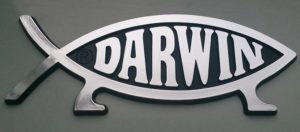In The God Delusion, Dawkins mentions memes briefly as a means to explain the origins of religion. The word “meme” was first coined by Richard Dawkins in his 1976 publication The Selfish Gene. He defines them as “units of cultural transmission analogous to the gene” (Blackmore 2). He further explains that natural selection proceeds in the interest of the genes and not the organism. It is not organisms that compete to survive, but rather the genes compete to be duplicated. The most successful replicators are those that band to create devices or vehicles that carry out their replication – in this case, our bodies. Dawkins ends his discussion with a question, “are there other replicators on the planet?” referring to memes. Dawkins fails to expand sufficiently on this subject which leaves the basis for memetic theory. Since then, the field of memetic theory has expanded significantly, which affected Dawkins’ later treatment of memes in The God Delusion.
Memetic theory
Memetic theory is based on Darwinian evolutionary principles. As genes were to our physical bodies, memes were the Darwinist replicators that explained the complexity of our minds, and thus our society. For evolution to occur, three factors must be present – heredity, variation, and selection (Blackmore 3). Memes are inherited through the copying of behaviors, and subtle variations are inevitable due the “reverse engineering” nature of meme replication. Selection occurs due to societal and personal pressures. It is important to note that evolution is an objective process with no special eye for its end products. As Dennett writes, “the evolutionary algorithm is a scheme for creating Design out of Chaos without the aid of Mind” (50). Dennett then takes this one step further and claims not only evolution does not have a specific goal, it does not have a specific medium either. It is only due to our familiarity with genes that we associate evolution with genes. According to Susan Blackmore, “it doesn’t matter which replicator… if memes are replicators then evolution will occur.” It is Blackmore herself who introduced the concept of Memeplexes, or groups of memes that are mutually beneficial to each others’ survival. Dawkins, in The God Delusion, then attributes the development and proliferation of religion to active memeplexes. At a later conference on “Do Memes Account for Culture”, held at King’s College, Cambridge, it was agreed that memes were not restricted specifically thoughts or behaviors, but “should be generally conceived as something more abstract” (Aunger).
Memetic theory with its greatest criticisms
However, it is due to this abstraction that presents memetic theory with its greatest criticisms. Assuming memes exist beyond a metaphorical sense, since memes are not directly observable, it is only possible to study the outcomes of acquiring them (Gatherer). Even with the lack of quantitative evidence, it is still quite apparent that memes differ from genes.
 Dawkins himself listed three further necessary factors for replicators to exist – fidelity, fecundity, and longevity (Boyd 11). Genes fit these three criteria because they are reproduced with extremely high accuracy, and they are maintained in their original state for the entirety of the organism’s lifespan. Memes, on the other hand, are heavily subject to change. It is not the actual meme that is copied, but rather the information induced from the physical projections (“phenotype”) of a meme (Boyd 11). The actual meme cannot be copied. Dawkins attempts to dismiss these criticisms in The God Delusion by insisting that “the details may wander idiosyncratically, but the essence passes down unmutated” (Dawkins, God 224). However, this is not so simple. Using religion as an example, an individual may have a set of beliefs. However, this set cannot be transmitted a whole since belief is not information but an attitude towards a set of information. The phenotype – behavior – can be copied, but whether behavior leads to belief is another matter entirely (Gatherer).
Dawkins himself listed three further necessary factors for replicators to exist – fidelity, fecundity, and longevity (Boyd 11). Genes fit these three criteria because they are reproduced with extremely high accuracy, and they are maintained in their original state for the entirety of the organism’s lifespan. Memes, on the other hand, are heavily subject to change. It is not the actual meme that is copied, but rather the information induced from the physical projections (“phenotype”) of a meme (Boyd 11). The actual meme cannot be copied. Dawkins attempts to dismiss these criticisms in The God Delusion by insisting that “the details may wander idiosyncratically, but the essence passes down unmutated” (Dawkins, God 224). However, this is not so simple. Using religion as an example, an individual may have a set of beliefs. However, this set cannot be transmitted a whole since belief is not information but an attitude towards a set of information. The phenotype – behavior – can be copied, but whether behavior leads to belief is another matter entirely (Gatherer).
REFERENCES
Aunger, Robert. “A Report On The Conference “Do Memes Account For Culture?” Held At King’s College, Cambridge.” Journal of Memetics – Evolutionary Models of Information Transmission 3.2. (1999): 123-131. Web. 3 April 2010.
Blackmore, Susan. “The Power of the Meme Meme” The Skeptic.: 5.2. (1997): 43-49. Web. April 7 2010.
Boyd, Robert and Richerson, Peter J. “Memes: Universal Acid or a Better Mouse Trap?” Conference on Memes held at Cambridge University. (1999). Web. 5 April 2010.
Dawkins, Richard. The God Delusion. London: Houghton Mifflin Harcourt, 2006. Print.
Dawkins, Richard. “The Selfish Meme.” Time Magazine. (1999). Web. April 11, 2010.
Dennet, Daniel. Darwin’s Dangerous Idea. London: Penguin, 1995. Print.
Gatherer, Derek. “Why the `Thought Contagion’ Metaphor is Retarding the Progress of Memetics.” Journal of Memetics – Evolutionary Models of Information Transmission 2.2. (1998): 135-138. Web. 1 April 2010.






